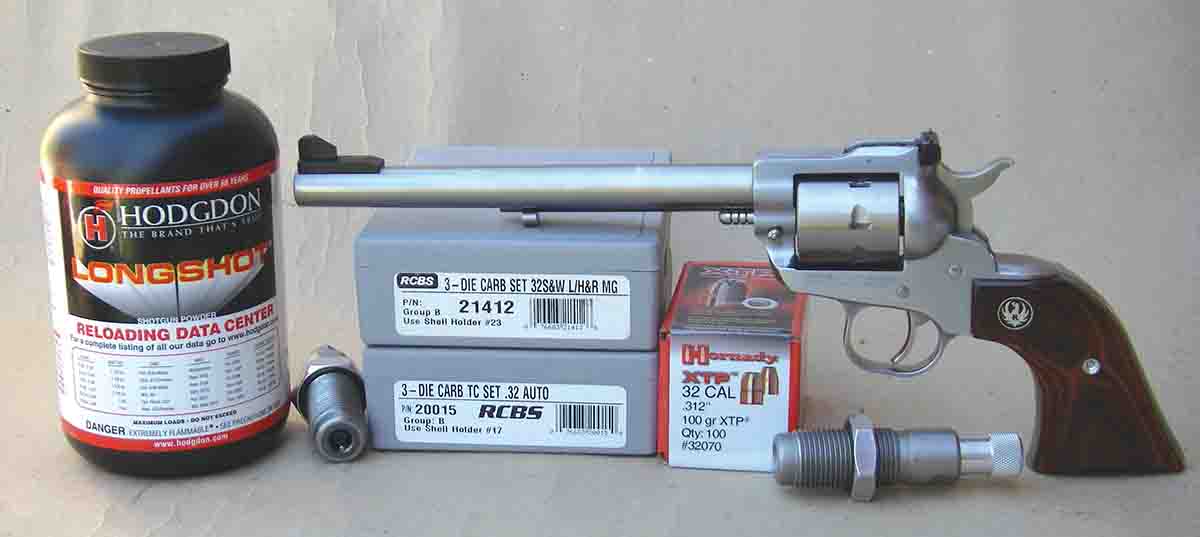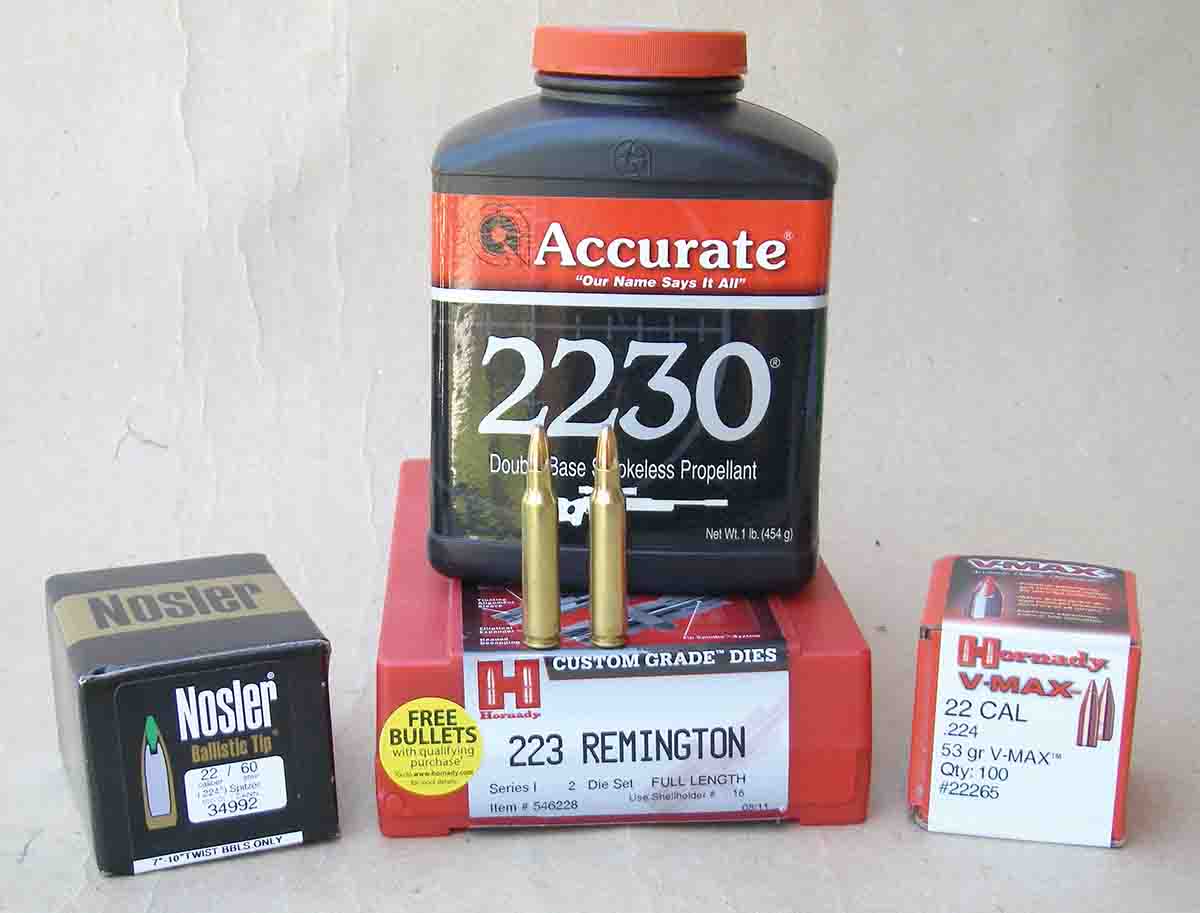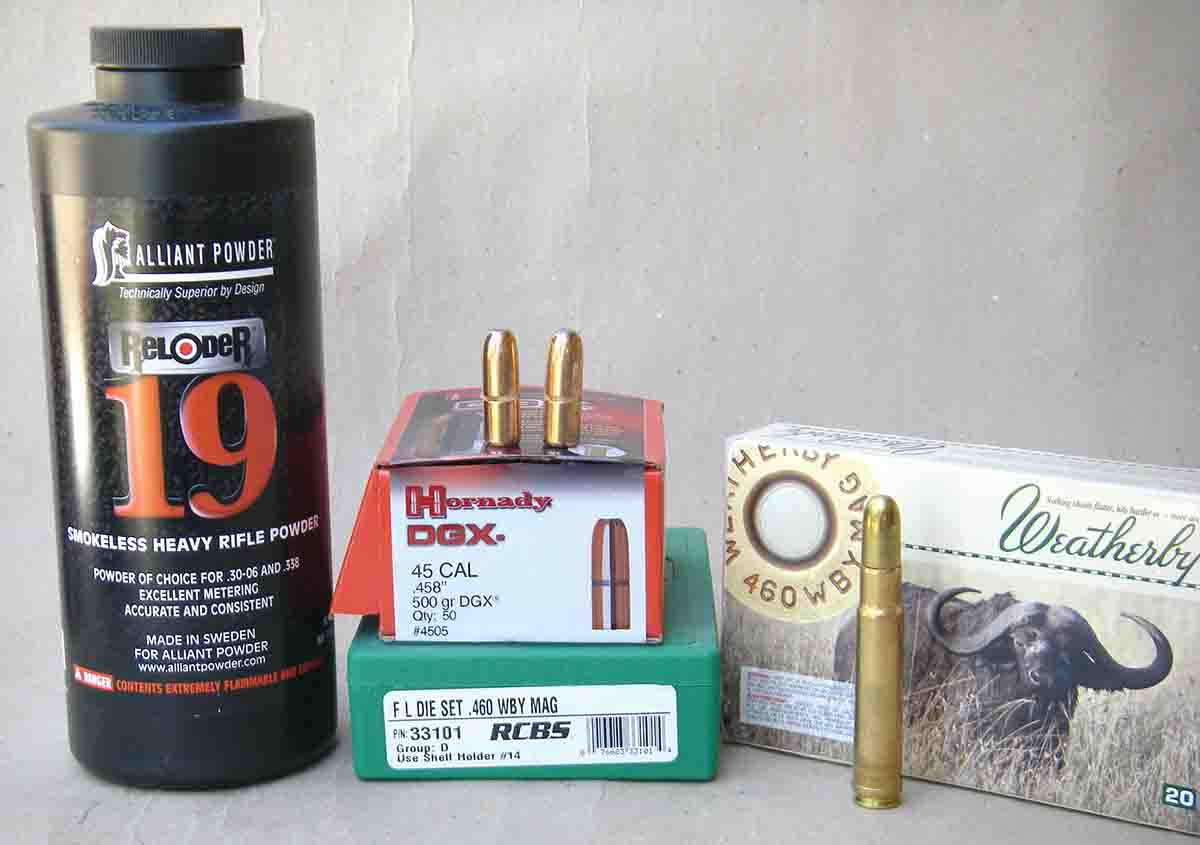Bullets & Brass
.327 Federal Magnum Data Problems
column By: Brian Pearce | February, 18

Q: My questions are in regard to your .327 Federal Magnum article found in Handloader No. 294 (Feb/March 2015). I have a Ruger Single-Seven with a 7½-inch barrel and have been experimenting with handloads but am having a problem. My issue is exactly as you mentioned in your article; large extreme velocity spreads that are sometimes in excess of 150 fps. I have tried the things that you mention to help, including using a small expander for better case tension, CCI #500 primers, etc. I am using Starline brass with a neck thickness of .010 inch. I am using RCBS dies marked “.32 S&W/.32 H&R.” The sizer die inside diameter is .332 inch, which with the .010 inch case neck provides very little tension. I obtained a .32 Auto sizer die, which has an inside diameter of .3295 inch and an expander ball that measures .3078 inch. This combination provides reasonable neck tension for the Hornady 100-grain XTP bullet. After sizing, I have been trimming all cases for uniformity and applying a heavy roll crimp. I am still getting excessive velocity spreads.
The last time that I shot the gun I noticed something odd. I was using Alliant 2400 powder with the Hornady 100-grain XTP bullet. Some of the loads produced much greater muzzle blast and flash. These were the loads that produced the lowest velocity. The shots with much less blast and muzzle flash were 150 fps faster. This really puzzles me. I had the same velocity issues with Alliant Power Pistol and Accurate No. 9 powders as well.
I have chronographed Federal factory ammunition and recorded 50 fps extreme spreads with both 85 and 100-grain loads. Any suggestions what to try next? Thanks. – M.K., Clifton, VA
A: You have correctly addressed many of the problems associated with assembling top-notch hand-loads in the .327 Federal Magnum. However, powder choice, bullet weight and primer combinations still play an important role in achieving match-type accuracy and performance.
Before proceeding, it should be noted that this cartridge has been challenging for small ammunition factories and handloaders alike. For example, in an effort to reduce the wild extreme spreads produced with conventional magnum revolver powders, and to better address the issues associated with a rather long powder column, Federal Cartridge had a specially formulated proprietary (noncanister) grade powder developed specifically for this cartridge, which is ignited with a comparatively hot Federal 200 primer. Federal’s powder choice has given it a distinct advantage when compared to what is available to handloaders. Nonetheless, several handloads produced equal and even better accuracy than all factory loads tested.
In an effort to better answer your question, I experimented with all readily available small pistol primers from Federal, CCI, Remington and Winchester, including standard and magnum versions. These tests included six powders and the Hornady 100-grain XTP bullet that you mention, as well as Federal and Starline cases. The results were interesting, but the full report cannot be discussed in this space.
The varying degrees of muzzle flash and large extreme spread swings that you experienced with Alliant 2400 powder are not uncommon with this cartridge. For several reasons I generally don’t use magnum primers with 2400 powder; however, in testing all primers with this powder and bullet combination, the Federal 200 gave the lowest extreme spreads and eliminated the ignition problems you were experiencing. Please note that some primers were producing an extreme spread of over 250 fps when using 13.0 grains. Extreme spread with the Federal 200 primer dropped to 90 fps (for 1,433 fps), which is far from perfect, but was the best combination with this particular powder and load, and it produced respectable accuracy.
When handloading this cartridge I still favor slightly faster- burning powders than traditional magnum revolver powders, such as Accurate No. 7, Alliant Power Pistol and Hodgdon Longshot. However, just like 2400, you must experiment with what primer works best with a given powder and charge weight. For example, using 7.8 grains of Power Pistol (1,518 fps from a Ruger Single-Seven with 7.5-inch barrel stoked with Hornady 100-grain XTP bullets), I was able to get the extreme spread down to 63 fps using the CCI 500 primer. The same load ignited with the Remington 1½ primer reached 1,450 fps and had an extreme spread of 216 fps. By contrast, 7.0 grains of Hodgdon Longshot reached 1,403 fps using a CCI 500 primer but had an unacceptable extreme spread of over 200 fps. Switching to a Federal 100 primer, velocity dropped slightly to 1,385 fps, but the extreme spread decreased to 52 fps. Using 9.2 grains of Accurate No. 7 with CCI 500 primers, velocity was 1,448 fps with an extreme spread of 67 fps; the Federal 100 primer produced essentially the same velocity with an extreme spread of 51 fps.
Please note that other primers with this load resulted in extreme spreads over 150 fps.
Here is where it gets a bit more complicated: In trying different lot numbers of primers from the same manufacturer, extreme spreads often changed. The point being, experiment with different primers with a given load, and then if possible stick with the lot number of primers that is giving the best results.
One other case prep item that will help lower extreme spreads is to uniform primer pockets. I hope that information helps, and thanks for taking the time to read our magazines.
New Revolver Barrel Break-In

Q: When you get a new revolver, do you perform a barrel break-in procedure? Your “Pet Loads .44 Special Standard Pressure” article inspired me to buy a Ruger GP100 in .44 Special. While looking in the bore there was an abundance of copper from whatever load the factory used to test fire it. The copper was mostly at the sides of the grooves. My question is should I shoot jacketed bullets to help smooth the bore before using cast bullets? I am looking forward to your “Pet Loads .44 Special +P” article like you did for the .45 Colt. – M.G., via e-mail
A: Yes, I do. My process is similar to popular rifle barrel break-in methods. I fire a single cartridge loaded with a jacketed bullet then completely clean the bore with a copper remover such as Butch’s Bore Shine, Bore Tech Inc. Copper Remover, etc., then lightly oil it, fire another round, then repeat for 10 to 20 shots. Next, I fire five shots consecutively, clean and repeat for the next 25 to 50 rounds, depending on bore type and appearance. Depending on the gun, steel type, rifling etc., I often fire up to 200 rounds of jacketed bullets through a new barrel, with cleaning intervals eventually being extended to every 25 to 50 shots. Stainless steel barrels can take considerably more break-in time and are always a good candidate for fire lapping to speed up the process. I hope this information helps.
.223 Remington Loads

Q: During the “great ammunition depression” of the past several years, I managed to accumulate a small supply of components so that I can keep my various .223 bolt action varmint rifles shooting. One powder that I managed to obtain was an 8-pound keg of Accurate 2230, which will replace my previous powder choice. I am looking for data with the 53-grain Hornady V-MAX and Nosler 52-grain HPBT bullets. Also, could you offer data for the 60-grain Nosler Ballistic Tip? – C.R., via e-mail
A: Using the Hornady 53-grain V-MAX bullet, start with 24.0 grains and work up to a maximum charge of 25.5 grains, which will reach 3,200 fps from most 22-inch barrels. The same powder charge can be used with the Nosler 52-grain HPBT. Switching to the 60-grain Nosler Ballistic Tip bullet, start with 23.0 grains and work up to a maximum charge of 24.5 grains, which will produce around 3,100 fps in most rifles. The above data was assembled using Winchester Small Rifle primers. If a magnum primer is used, maximum charges will need to be reduced slightly.
.460 Weatherby Magnum Recipes

Q: I have been shooting a .458 Winchester Magnum for years – both for fun and hunting large African game. It has served me well, but I finally opted to purchase a .460 Weatherby Magnum for its substantial velocity increases with the same bullets.
Now I need some load recipes to help reduce shooting costs. I am going to use a variety of 500-grain solid and expanding bullets and am looking for a load that will duplicate Weatherby factory loads with that bullet weight. Do you know what powder and grain charge they use? Any help you can offer would be appreciated. – K.Z., via e-mail
A: Weatherby advertises two factory loads containing 500-grain bullets (roundnose expanding and FMJ) at a velocity of 2,600 fps. While I can offer you handload data that will duplicate the advertised ballistics, I do not know the exact pressure of these loads. For that reason I will suggest a load that is only slightly below advertised factory load velocities, which will not make any practical difference in the field when used on heavy or dangerous game and is within SAAMI pressure guidelines. Using either the Hornady DGS or DGX 500-grain bullets, try 122.0 grains of Vihtavuori N160 or 125.0 to 125.5 grains of Alliant Reloder 19 powder, which will each chronograph around 2,550 fps from a 26-inch barrel. You will want to use the Federal 215 Large Rifle Magnum primer to achieve reliable ignition.


